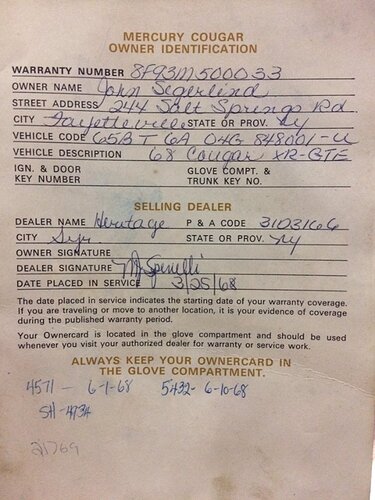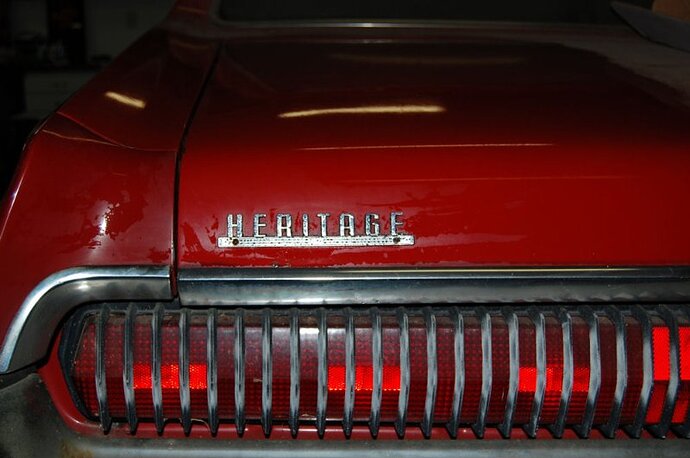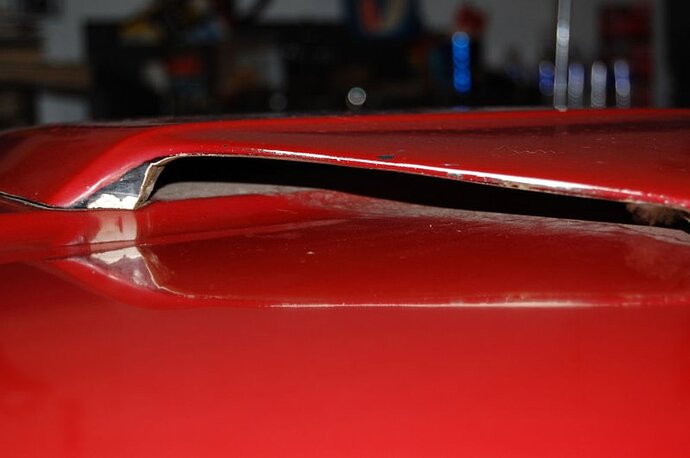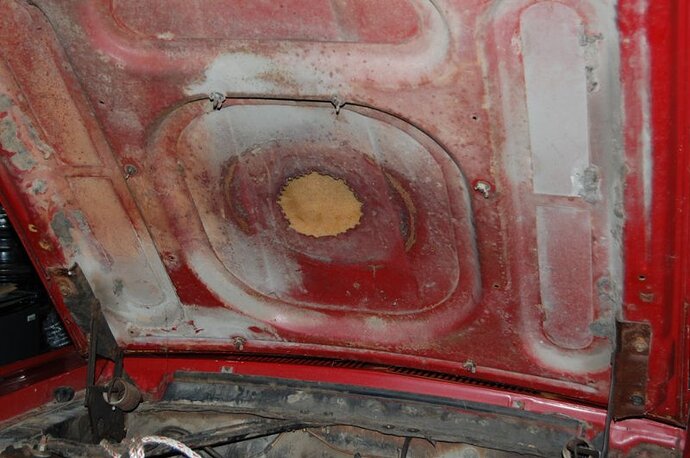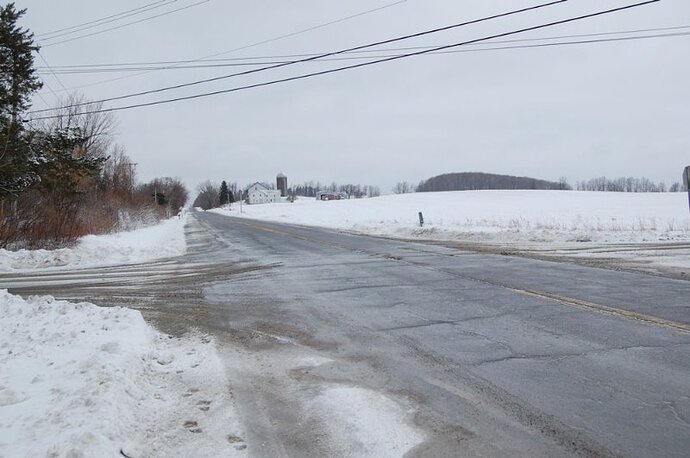I appreciate that Royce. And I appreciate your time that I’ve been spending on it too.
Be still my heart! Bundy finally got off his duff and is doing something!!! I could have built another Isabel while I waited for the day! LOL.
It’s about time Al, good on 'ya.
I for one, am still waiting for you to build another Isabel.
Great to hear that you’re making time for your special Cougar. I look forward to seeing your updates.
Steven
When this one gets finished, does it bring the total to 4, of done show cars?
Phil and John’s cars are finished, Stuart’s has always been a driver.
That would be a question for Mr. Pinkerton. I’m not sure disclosing that information on a public forum is acceptable.
Scott,
Are you talking just 1968?
Are there any non GTE show cars that are also “done”?
Based on his post he is referring to GTE only.
January 10, 1968 was the start of the long anticipated Syracuse Automobile Dealers Association annual show. It was the height of the muscle car era and this was a chance to see first-hand all the new offerings from every manufacturer in the country. And some from overseas makers as well. One such offering was a hefty performance upgrade to the fledgling Mercury Cougar in the form of the GT-E package. It was the only model from Ford Motor Co. in 1968 to offer the venerable 427 and as it turned out, the last model ever. Mercury was looking to make a big impression on the performance car market. Whether or not they actually succeeded, they certainly did make an impression on one of the attendees at the Syracuse Auto Show.
This photo is from the Detroit Auto Show displaying a pre-production GT-E
That young gentleman was John Segerlind of Fayetteville, NY. In fact the car made such an impression on him, he convinced one of the local Lincoln-Mercury dealers, Heritage, to sell him the car. The details of that transaction unfortunately have been lost to time. Standard practice would have been for the show units to be returned to Ford and destroyed. For some reason in 1968 this particular car, number 500033, along with others was released and sold to the general public. Though based on the information available, it was far from an expedient process. The image below of the original owner’s manual shows a lengthy delay between the auto show and the actual sale date.
Notice the incorrect VIN character M which should be a W
It was incorrect on the registration as well. It’s since been corrected.
Mr. Segerlind’s exploits with the car were somewhat short lived though not without consequence. His personal touches included removing the caps from the shock towers, adding a pair of taillights to the package tray, cutting out the blocked off portion of the hood scoop, cutting a jagged hole in the hood with who knows what kind of tool and hitting one of the quarter extensions hard enough to crack it. That was replaced and repainted by the dealer though it stands out not matching the original paint and lacking pin stripes. By the time mid-summer rolled around, the car was brought to Koerner Ford and traded in towards a Cobra Jet Torino. The Cougar purportedly wasn’t fast enough for its original owner. Because it was brought to the dealer with a fairly prominent engine knock, they were more than happy to allow next to nothing for the trade in. That’s where chapter 2 begins.
Examples of the handy work of the original owner
Lloyd Scanlon grew up on a dairy farm in Central New York in what was at the time very much a rural area. By some standards it still is. He was no stranger to turning wrenches or fast cars as this was the predominant activity of the time. He built a ’56 Ford that in his words “ran pretty good” and shared the fact that a local sheriff used to chase him home when he still lived on the farm. Not with any intent of issuing tickets, but only with a desire to drive the car. It certainly was a different time back then. A few years later he wound up working a local Ford dealership after a brief stint at a Chrysler Plymouth dealer. He always spoke highly of the facility, though being a Ford guy through and through he obviously couldn’t stay. As fate would have it, he was working the Saturday afternoon after the GT-E was traded in. It wasn’t uncommon for some of the more ambitious guys to work weekends, at that time they were paid well for their work especially if you were good at it. It wasn’t until a couple years later that they were converted to hourly jobs and the dealer started making all the money.
This particular afternoon an acquaintance stopped in the shop by the name of Eddie Russell. I don’t know much about him save the fact that he was a local racer and at one point was employed at Transitowne Dodge in Williamsville, NY.
First words out of Ed’s mouth were “Hey Lloyd is that Cougar out there a 427?” Of course a look under the car quickly revealed it was which brought the next question “Are you going to buy it?” The moment of truth so to speak. Having missed out on a ’57 Thunderbird only days earlier that he desperately wanted, the answer was easy. Yes Ed I’m going to buy it. First thing Monday a deal was struck with the head of sales for the used GT-E with the engine knock. Perhaps a quick inspection should have been asked for before they sold the car, but no one seemed too interested. The paperwork was completed and the 4 month old car was sold for the whopping sum of $2200. Of course being an employee, had anyone asked, Lloyd would have been obligated to tell them the engine knocked because it only had two quarts of oil. The last of Segerlind’s faux pas turned out to be a boon for the next owner.
Next came the process of turning the GT-E into the street rod that Scanlon knew it could be. Much was already known about the potential of the 427 side oiler, and a few things were yet to be discovered. The trip to the machine shop revealed one cylinder slightly offset a not uncommon occurrence with the 427’s. The intent was not to bore it to .030 over from the start, that’s what was needed to correct the geometry. Oil galleys were plugged, the cam was changed and solid lifters were installed. The crankshaft was swapped for a 428 to achieve a longer stroke, the 600 CFM carb replaced by an 850 double pumper. A pair of high riser heads to compliment the Ford racing pistons and Lemans rods were added. These were swapped out a short time later in favor of medium riser heads with sodium valves. The distributor was replaced with a dual point mechanical unit, the stock coil was changed for a performance coil and the fuel pump came off in favor of a higher volume pump. The oil pan was replaced with a deeper pan and a high volume oil pump. The original radiator and clutch fan were both replaced to help alleviate cooling issues. And of course the original valve covers got tossed for a set of Mickey Thompson. The original exhaust system was replaced with a set of headers and four glass packs for mufflers. Other notable changes to the car were a mechanical oil gauge, a 10,000 RPM tach, larger wheels and a 4.30 locker for a rear end. There are likely a few things I missed, I’m fairly certain that the C6 wasn’t being run in stock form and I suspect it has a different torque converter. Both still reside in the car for now.
The results were pretty astounding. The GT-E was suddenly the fastest street car in Central New York. Quite a bit of money changed hands during it’s time on the road including some from the previous owner’s pocket running his Torino. The one and only time the GT-E ever lost a race was the finals in its only appearance at a track. The site was Fulton, NY unfortunately I can’t give an exact date. Despite the car not running the way he would have liked, Lloyd decided to stay and race anyway. In the finals he was matched up against a Hemi Cuda. The Plymouth was lucky to walk away with the win, the Cougar was going by him in the traps. After returning home the culprit was discovered in the form of a broken timing gear. That day did provide the only recorded data available in the cars history. The table below shows the recorded 1/8 mile speed of 99.99 mph.
1/8 mile 1/4 mile
MPH 99.99 123.99
ET 6.83 10.69
HP 528
With the exception of the already noted speed these numbers are calculated using multiple sources. Of course there is margin for error
Many a Chevy and Mopar left this stretch of road a little poorer.
The spring of 1975 saw the GT-E’s service come to a halt. It had remained a driver during the summers, but by then the drag racing was slowly starting to diminish. On the way home from a mundane trip, a sodium exhaust valve broke and sidelined the car. Speculation was that either fatigue or running them a little too tight was the cause. There was extensive damage to one of the pistons and some damage to the cylinder wall. Remains of the valve were never found, apparently it was crunched up and forced out the exhaust. The car was parked, my recollection is it did sit outdoors for one winter. The remainder of the next 35 years were spent in the garage.
I’ll stop there for now, as I hope there are at least a few anxious people waiting to read this. The next part of the story is not a part of the origin, but rather the part I’ll call “discovery.” It’s somewhat interesting and will bring us up to the present day.
Great story!
I am guessing your dad was a frequent customer of Drake Viscone / Vindicator Racing.
https://eastcoastdragtimeshalloffame.com/drake-viscome-the-vindicator/
Excellent stuff John (oops!), thanks for sharing. I think I would have really enjoyed rubbing elbows with Lloyd!
I am guessing your dad was a frequent customer of Drake Viscone / Vindicator Racing.
No connection to my knowledge. Though I’m sure he knew the name. Carmel is a long way from Syracuse.
Excellent stuff John (oops!), thanks for sharing. I think I would have really enjoyed rubbing elbows with Lloyd!
No worries Robert. The names weren’t changed to protect the innocent.
Love the story so far. Waiting for more and of course any vintage images to go along with the story. Needs to be added to an update to the GT-E book or a future ATSOTC article.
Unfortunately Gavin I do not have a single vintage photo. My parents were never big on taking pictures. There are still some pictures of me when I was a kid, but beyond that not much.

